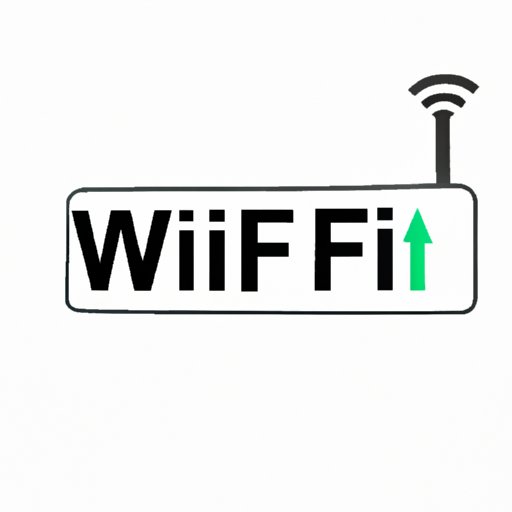
I. Introduction
Weak WiFi signals are a common problem faced by many people, especially those living in large homes or properties with thick walls. This issue can be frustrating, as it can cause slow internet speed, connection drops, and loss of productivity. Having a strong and reliable WiFi connection is increasingly important in today’s fast-paced world, where we rely heavily on the internet for daily tasks such as work, shopping, and entertainment. In this article, we will discuss some effective ways to boost your WiFi signal and ensure a fast and reliable connection at all times.
II. Repositioning of the Router
One of the simplest ways to improve your WiFi signal quality is by repositioning your router. WiFi signals can be weakened by physical obstructions such as walls, furniture, and appliances. Therefore, it’s essential to place your router in a strategic location where it can transmit signals freely.
To determine the best location for your router, consider placing it in a central location, away from walls, appliances, and other sources of interference. Also, make sure it is placed at a reasonable height and not too close to the floor or ceiling.
Your room or house’s physical layout can also affect your WiFi signal strength. For instance, if your house has multiple floors, you may need to place your router on the highest level and avoid positioning it near metal structures and wires.
III. Upgrade the Antennas
Another way to improve your WiFi signal strength is by upgrading or replacing your router’s antennas. This can be particularly useful if your existing antennas are old, damaged, or not powerful enough to meet your needs.
When choosing new antennae, make sure they are compatible with your router and are designed for your specific needs. For example, if you need to extend your WiFi signals to an outdoor area, you may need to consider getting omnidirectional or directional antennae. Once you have your new antennae, follow the manufacturer’s instructions for installation and configuration.
IV. Reduce Interference
WiFi signals can be disrupted by various sources of interference, such as other wireless devices, microwaves, and other appliances. To reduce interference, you can take the following steps:
- Move your router away from other wireless devices
- Switch off appliances that emit WiFi signals, such as microwaves and cordless phones
- Place your router on a higher level to reduce signal interference from walls and other obstructions
You can also modify your mobile devices and appliances by installing WiFi signal filters or purchasing interference-free devices. Another option is to shift to a different WiFi channel or frequency band, depending on your router’s specifications.
V. Update Your Router’s Firmware
Your router’s firmware is the software that controls its features and functions. Like any other software, firmware updates are essential to fix bugs and improve performance.
Updating your router’s firmware is relatively easy and can typically be done through a web interface. To do this, navigate to your router’s settings page, and look for the firmware update option. Before updating your firmware, make sure to read the manufacturer’s instructions and backup your router’s current settings. Once the update is complete, check if your WiFi signal has improved.
VI. Use a WiFi Extender
If you’re having trouble extending WiFi signals to specific areas in your home or office, such as basements and outdoor areas, a WiFi extender might be the solution. WiFi extenders are devices that work by receiving your router’s signals and then retransmitting them to distant locations. By doing so, they help boost signal strength and improve wireless coverage.
When selecting a WiFi extender, it’s essential to consider factors like the size and layout of your property, your router’s specifications, and the extender’s compatibility. Some of the tips for installing a WiFi extender include placing it in a central location, using the same SSID and password as your router, and ensuring it’s protected with solid encryption.
VII. Use a Mesh Network System
A Mesh Network System is considered the most powerful, modern, and effective way to improve your WiFi signal strength. Mesh networks utilize multiple nodes or devices to create a seamless and robust network that can extend the WiFi coverage to even the most remote places in your home or office.
Mesh networks are easy to set up and use. They work by using a central router that communicates with satellite devices, which are installed throughout the property. The satellite devices transmit signals to each other, acting as a type of relay until the signals reach their intended destination.
When selecting a Mesh Network System, consider factors such as coverage range, compatibility, and price. Some of the tips for setting up a Mesh Network System include placing devices in central locations, ensuring that each device is within range of the others, and configuring the system using the manufacturer’s instructions.
VIII. Conclusion
In conclusion, boosting your WiFi signal requires a combination of different approaches, including repositioning your router, replacing the antennas, reducing interference, updating firmware, using a WiFi extender, or a Mesh Network System. By trying the different solutions discussed in this article, you can effectively improve your WiFi signal strength, enjoy faster internet speed, and eliminate connectivity issues.
Remember, having a strong and reliable WiFi connection is critical for productivity, entertainment, and communication, especially in this digital age.





